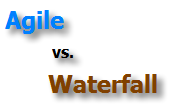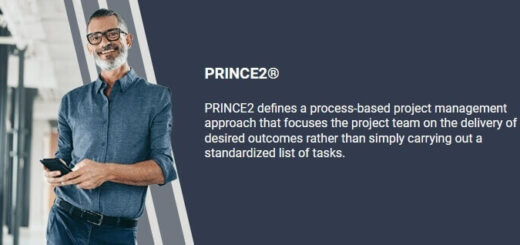Going Agile vs Waterfall Approach? Custom Project Management is Better
 The question ‘What is better – Agile or Waterfall?‘ remains open, even regardless that both approaches are well defined and their best practices are explored and proven for given business environments. Because different companies have different values, every organization needs to decide on either a traditional, step-by-step project management approach or an iterative-based, highly-adaptive method for planning and managing the business objectives. But is there another option, except for considering Agile vs Waterfall approach? Apparently, there is. Custom project management (PM) provides a framework that combines traditional PM methods with adaptive, iteration-driven practices. Today many businesses begin to customize the way they plan and do their business projects to tailor their PM approach to their business needs.
The question ‘What is better – Agile or Waterfall?‘ remains open, even regardless that both approaches are well defined and their best practices are explored and proven for given business environments. Because different companies have different values, every organization needs to decide on either a traditional, step-by-step project management approach or an iterative-based, highly-adaptive method for planning and managing the business objectives. But is there another option, except for considering Agile vs Waterfall approach? Apparently, there is. Custom project management (PM) provides a framework that combines traditional PM methods with adaptive, iteration-driven practices. Today many businesses begin to customize the way they plan and do their business projects to tailor their PM approach to their business needs.
Two Leading PM Approaches – Agile and Waterfall
In the theory and practice of project management, there are two leading PM approaches that determine the different ways of doing projects effectively and efficiently. One approach is called “traditional” (Waterfall, examples are PRINCE2, the guidelines and standards by PMI’s PMBOK, etc.) and another one is known as “adaptive” (Agile, examples are SCRUM, Extreme Programming, others). Each of the methods is widely used in business organizations for different projects, and both can produce different results.
In simple terms, the core difference between Waterfall and Agile is in how the constraints of scope, budget, schedule and quality are considered and managed.
The traditional ‘Waterfall’ approach requires that these four constraints should be considered under equal importance and be defined in advance, at project beginning. Special emphasis needs to be placed on planning as the core management function that ensures success of project effort. By using this PM approach an organization can create a long-term plan and manage their business projects according to this plan; and only some little changes to the plan are acceptable.
On the contrary, the adaptive ‘Agile’ approach tends to juggle around the constraints to prioritize one over the others. Priorities can be re-considered many times throughout the project lifecycle in order to ensure greater adaptability of the development process to ever-changing circumstances. An organization that employs this PM approach is enabled to change their behavior rapidly to adapt to different economic, operating and competitive conditions. For this organization, the process of long-term planning and forecasting appears to be unacceptable and costly; the project performance will be better only if the team uses iterations and adaptive techniques for addressing the constraints.
Agile vs Waterfall Approach – Basic Considerations
When an organization needs to decide on the right approach for managing projects, it needs to look at the following considerations:
- Business Objective. Which of the approaches will most likely address our business objectives?
- Project Complexity. How complex will be our project? Will we need to employ both approaches in managing separate elements of the project? If so, what approach will best suit which element?
- Methodologies Combination. If our project is complex and requires both PM methodologies for use, can we find a mechanism to effectively combine the ‘Waterfall’ and ‘Agile’ components in the project?
A Custom PM Framework of Agile Iterations and Waterfall Planning
Many firms today employ traditional Waterfall planning approach but within their own custom framework that has been proven to work fine within their business environment. Often, this customization takes some form of an iterative Agile method, so that the project develops within a predictive enough environment and never gets too far down the plan before a critical problem is discovered. The framework involves use of iterations to identify, define and find solution to a problem early prior to this problem turns critical. Even a long-term Waterfall-based plan is managed under iterations, and the key constraints of scope, schedule, budget and quality are addressed according to changing priorities in the short run.
Custom Project Management
As said above, customization in project management excludes any comparisons like Agile vs Waterfall. Instead, it means that you need to mix best practices of both PM approaches and try to create a new framework that is tailored to your special business needs. Particularly, you would begin your project with defining the first set of deliverables but wouldn’t go with this set throughout the entire project. You would rather schedule a requirements gathering phase to test, correct and prove the first deliverables set and then move on to plan the next stage of the project, and so on. It would look like a staged approach to managing the project.
Meanwhile, your overall business strategy remains the same and does not get dependent on PM effort. In this situation, PM becomes a secondary priority while the business objectives of your organization are handled at top priority level. This approach to custom project management is great for market followers, or organizations that are seeking to either position themselves within a changing macro and micro environment.
Disadvantage Turns into Advantage
A disadvantage of mixed Agile and Waterfall project management can be the necessity to go back and re-consider project deliverables as a more extended understanding of the overall picture is gained. Thus more time will be required to do the project, and it will take longer to gain the business benefits.
At the same time, this disadvantage turns into an advantage for companies (new ventures and market leaders) that want to build their future, which is unpredictable and challenging greatly. For such businesses, Agile approach best practices in combination with Waterfall PM templates will arguably minimize number of disruptions, because problems are revealed and addressed sooner. And those companies won’t prioritize an unexpected impact on costs and time, but they rather focus on managing other constraint of quality and scope. This means they would prefer better and extended development (quality and scope) of their venture business to increased cost and time (budget and schedule).













